Mechanical Properties and Shrinkage Behavior of Concrete-Containing Graphene-Oxide Nanosheets
Abstract
:1. Introduction
2. Experimental Setups
2.1. Mechanical Properties Test for Concrete Containing GO Nanosheets
2.1.1. Material and Instrument
2.1.2. Mixture Ratio
2.1.3. Sample Preparation and Test
2.2. Drying Shrinkage Test
2.2.1. Mixture Ratio
2.2.2. Preparation and Test
3. Experimental Results
3.1. Mechanical Properties
3.1.1. Compressive Strength
3.1.2. Flexural Strength
3.1.3. Elasticity Modulus
3.2. Drying Shrinkage Effect
4. Discussion
5. Concluding Remarks
- (1)
- GO nanosheets can considerably improve the compressive strength at the age of 3, 7 and 28 days. The higher the GO dosage is, the more obvious the strength increase will be. GO nanosheets of different contents can increase the compressive strength of concrete at the age of 28 days by 4.04–12.65%. GO nanosheets can considerably improve the compressive strength of concrete at the age of 3 d the most obviously by 5.02–21.51%.
- (2)
- GO nanosheets can increase the flexural strength of concrete, but the increasing degree is lower than that of compressive strength. Its effect on early-stage strength is comparatively significant, and the most obvious effect happens on the 3rd day (4.25–13.06%). The enhancement effect of flexural strength on the 28th day reaches 3.8–7.38%. Moreover, the flexural strength of concrete will be further improved with the increase of GO nanosheets content.
- (3)
- The enhancement effect of GO nanosheets on early-stage elasticity modulus of concrete is relatively big. The higher the GO content is, the higher the increasing rate of elasticity modulus will be. GO nanosheets can increase the elasticity modulus of concrete at the age of 3 days by 6.05–27.46%, and increase the elasticity modulus at the age of 28 days by 3.92–10.97%.
- (4)
- GO nanosheets will increase the shrinkage strain of ordinary concrete. The higher the content is, the more obvious the enhancement effect will be. GO nanosheets have a comparatively big influence on the increase of early-stage shrinkage strain of ordinary concrete. At the age of 60 days, the GO dosages of 0.02 wt%, 0.05 wt % and 0.08 wt % can increase the shrinkage strain of ordinary concrete by 1.99%, 5.79% and 7.45%, respectively.
Author Contributions
Funding
Conflicts of Interest
References
- Shi, C.J.; Wu, Z.M.; Xiao, J.F.; Wang, D.H.; Huang, Z.Y.; Fang, Z. A review on ultra high performance concrete: Part I. Raw materials and mixture design. Constr. Build. Mater. 2015, 101, 741–751. [Google Scholar] [CrossRef]
- Huang, L.P.; Hua, J.M.; Kang, M.; Luo, Q.M.; Zhou, F.B. Influence of Steel Plates and Studs on Shrinkage Behavior and Cracking Potential of High-Performance Concrete. Materials 2019, 12, 342. [Google Scholar] [CrossRef] [PubMed] [Green Version]
- Huang, L.P.; Hua, J.M.; Kang, M.; Zhang, A.L. Influence of reinforcement configuration on the shrinkage and cracking potential of high-performance concrete. Constr. Build. Mater. 2017, 140, 20–30. [Google Scholar] [CrossRef]
- Rafiee, M.; Nitzsche, F.; Laliberte, J.; Hind, S.; Robitaille, F.; Labrosse, M.R. Thermal properties of doubly reinforced fiberglass/epoxy composites with graphene nanoplatelets, graphene oxide and reduced-graphene oxide. Compos. Pt. B Eng. 2019, 164, 1–9. [Google Scholar] [CrossRef]
- Zhu, Y.W.; Murali, S.; Cai, W.W.; Li, X.S.; Suk, J.W.; Potts, J.R.; Ruoff, R.S. Graphene and Graphene Oxide: Synthesis, Properties, and Applications. Adv. Mater. 2010, 22, 3906–3924. [Google Scholar] [CrossRef] [PubMed]
- Rafiee, M.; Nitzsche, F.; Laliberte, J.; Thibault, J.; Labrosse, M.R. Simultaneous Reinforcement of Matrix and Fibers for Enhancement of Mechanical Properties of Graphene-Modified Laminated Composites. Polym. Compos. 2019, 40, E1732–E1745. [Google Scholar] [CrossRef]
- Lv, S.; Ma, Y.; Qiu, C.; Sun, T.; Liu, J.; Zhou, Q. Effect of graphene oxide nanosheets of microstructure and mechanical properties of cement composites. Constr. Build. Mater. 2013, 49, 121–127. [Google Scholar] [CrossRef]
- Chuah, S.; Pan, Z.; Sanjayan, J.G.; Wang, C.M.; Duan, W.H. Nano reinforced cement and concrete composites and new perspective from graphene oxide. Constr. Build. Mater. 2014, 73, 113–124. [Google Scholar] [CrossRef]
- Xu, Y.; Zeng, J.; Chen, W.; Jin, R.; Li, B.; Pan, Z. A holistic review of cement composites reinforced with graphene oxide. Constr. Build. Mater. 2018, 171, 291–302. [Google Scholar] [CrossRef]
- Qureshi, T.S.; Panesar, D.K. Impact of graphene oxide and highly reduced graphene oxide on cement based composites. Constr. Build. Mater. 2019, 206, 71–83. [Google Scholar] [CrossRef]
- Cheng, Y.; Zhang, Y.; Jiao, Y.; Yang, J. Quantitative analysis of concrete property under effects of crack, freeze-thaw and carbonation. Constr. Build. Mater. 2016, 129, 106–115. [Google Scholar] [CrossRef]
- Hogancamp, J.; Grasley, Z. The use of microfine cement to enhance the efficacy of carbon nanofibers with respect to drying shrinkage crack resistance of portland cement mortars. Cem. Concr. Compos. 2017, 83, 405–414. [Google Scholar] [CrossRef]
- Shaha, S.P.; Houb, P.; Konsta-Gdoutos, M.S. Nano-modification of cementitious material: toward a stronger and durable concrete. J. Sustain. Cem. Mater. 2016, 5, 1–22. [Google Scholar]
- Pei, H.; Zhang, S.; Bai, L.; Hou, D.; Yang, Q.; Borana, L. Early-age shrinkage strain measurements of the graphene oxide modified magnesium potassium phosphate cement. Measurement 2019, 139, 293–300. [Google Scholar] [CrossRef]
- Wang, M.; Yao, H.; Wang, R.; Zheng, S. Chemically functionalized graphene oxide as the additive for cement-matrix composite with enhanced fluidity and toughness. Constr. Build. Mater. 2017, 150, 150–156. [Google Scholar] [CrossRef]
- Li, W.G.; Li, X.Y.; Chen, S.J.; Liu, Y.M.; Duan, W.H.; Shah, S.P. Effects of graphene oxide on early-age hydration and electrical resistivity of Portland cement paste. Constr. Build. Mater. 2017, 136, 506–514. [Google Scholar] [CrossRef]
- Li, X.; Liu, Y.M.; Li, W.G.; Li, C.Y.; Sanjayan, J.G.; Duan, W.H.; Li, Z. Effects of graphene oxide agglomerates on workability, hydration, microstructure and compressive strength of cement paste. Constr. Build. Mater. 2017, 145, 402–410. [Google Scholar] [CrossRef]
- Li, C.Y.; Chen, S.J.; Li, W.G.; Li, X.Y.; Ruan, D.; Duan, W.H. Dynamic increased reinforcing effect of graphene oxide on cementitious nanocomposite. Constr. Build. Mater. 2019, 206, 694–702. [Google Scholar] [CrossRef]
- Wang, Q.; Cui, X.; Wang, J.; Li, S.; Lv, C.; Dong, Y. Effect of fly ash on rheological properties of graphene oxide cement paste. Constr. Build. Mater. 2017, 138, 35–44. [Google Scholar] [CrossRef]
- Chen, Z.S.; Zhou, X.; Wang, X.; Guo, P. Mechanical behavior of multilayer GO carbon-fiber cement composites. Constr. Build. Mater. 2018, 159, 205–212. [Google Scholar] [CrossRef]
- Li, X.Y.; Li, C.Y.; Liu, Y.M.; Chen, S.J.; Wang, C.M.; Sanjayan, J.G.; Duan, W.H. Improvement of mechanical properties by incorporating graphene oxide into cement mortar. Mech. Adv. Mater. Struct. 2018, 25, 1313–1322. [Google Scholar] [CrossRef]
- Long, W.J.; Gu, Y.c.; Xiao, B.X.; Zhang, Q.m.; Xing, F. Micro-mechanical properties and multi-scaled pore structure of graphene oxide cement paste: Synergistic application of nanoindentation, X-ray computed tomography, and SEM-EDS analysis. Constr. Build. Mater. 2018, 179, 661–674. [Google Scholar] [CrossRef]
- He, J.; Du, S.; Yang, Z.; Shi, X. Laboratory investigation of graphene oxide suspension as a surface sealer for cementitious mortars. Constr. Build. Mater. 2018, 162, 65–79. [Google Scholar] [CrossRef]
- Mokhtar, M.M.; Abo-El-Enein, S.A.; Hassaan, M.Y.; Morsy, M.S.; Khalil, M.H. Mechanical performance, pore structure and micro-structural characteristics of graphene oxide nano platelets reinforced cement. Constr. Build. Mater. 2017, 138, 333–339. [Google Scholar] [CrossRef]
- Kang, X.; Zhu, X.; Qian, J.; Liu, J.; Huang, Y. Effect of graphene oxide (GO) on hydration of tricalcium silicate (C3S). Constr. Build. Mater. 2019, 203, 514–524. [Google Scholar] [CrossRef]
- Ma, H.Y.; Tian, Y.; Li, Z.J. Interactions between Organic and Inorganic Phases in PA- and PU/PA-Modified-Cement-Based Materials. J. Mater. Civ. Eng. 2011, 23, 1412–1421. [Google Scholar] [CrossRef]
- Silva, D.A.; Roman, H.R.; Gleize, P.J.P. Evidences of chemical interaction between EVA and hydrating Portland cement. Cem. Concr. Res. 2002, 32, 1383–1390. [Google Scholar] [CrossRef]
- Shang, Y.; Zhang, D.; Yang, C.; Liu, Y.Y.; Liu, Y. Effect of graphene oxide on the rheological properties of cement pastes. Constr. Build. Mater. 2015, 96, 20–28. [Google Scholar] [CrossRef]
- Liu, H.; Yu, Y.; Liu, H.; Jin, J.; Liu, S. Hybrid effects of nano-silica and graphene oxide on mechanical properties and hydration products of oil well cement. Constr. Build. Mater. 2018, 191, 311–319. [Google Scholar] [CrossRef]
- Long, W.J.; Ye, T.H.; Gu, Y.C.; Li, H.D.; Xing, F. Inhibited effect of graphene oxide on calcium leaching of cement pastes. Constr. Build. Mater. 2019, 202, 177–188. [Google Scholar] [CrossRef]
- Vijayaraghavan, V.; Zhang, L.C. Tensile and Interfacial Loading Characteristics of Boron Nitride-Carbon Nanosheet Reinforced Polymer Nanocomposites. Polymers 2019, 11, 1075. [Google Scholar] [CrossRef] [PubMed] [Green Version]
- Chen, Z.S.; Xu, Y.M.; Hua, J.M.; Zhou, X.; Wang, X.; Huang, L.P. Modeling Shrinkage and Creep for Concrete with Graphene Oxide Nanosheets. Materials 2019, 12, 3153. [Google Scholar] [CrossRef] [Green Version]
- Gong, K.; Pan, Z.; Korayem, A.H.; Qiu, L.; Li, D.; Collins, F.; Wang, C.M.; Duan, W.H. Reinforcing Effects of Graphene Oxide on Portland Cement Paste. J. Mater. Civ. Eng. 2015, 27, 6. [Google Scholar] [CrossRef]
- Tong, T.; Fan, Z.; Liu, Q.; Wang, S.; Tan, S.S.; Yu, Q. Investigation of the effects of graphene and graphene oxide nanoplatelets on the micro- and macro-properties of cementitious materials. Constr. Build. Mater. 2016, 106, 102–114. [Google Scholar] [CrossRef]
- Scrivener, K.L.; Crumbie, A.K.; Laugesen, P. The interfacial transition zone (ITZ) between cement paste and aggregate in concrete. Interface Sci. 2004, 12, 411–421. [Google Scholar] [CrossRef]
- Demie, S.; Nuruddin, M.F.; Shafiq, N. Effects of micro-structure characteristics of interfacial transition zone on the compressive strength of self-compacting geopolymer concrete. Constr. Build. Mater. 2013, 41, 91–98. [Google Scholar] [CrossRef]
- Zhao, L.; Guo, X.; Liu, Y.; Zhao, Y.; Chen, Z.; Zhang, Y.; Guo, L.; Shu, X.; Liu, J. Hydration kinetics, pore structure, 3D network calcium silicate hydrate, and mechanical behavior of graphene oxide reinforced cement composites. Constr. Build. Mater. 2018, 190, 150–163. [Google Scholar] [CrossRef]


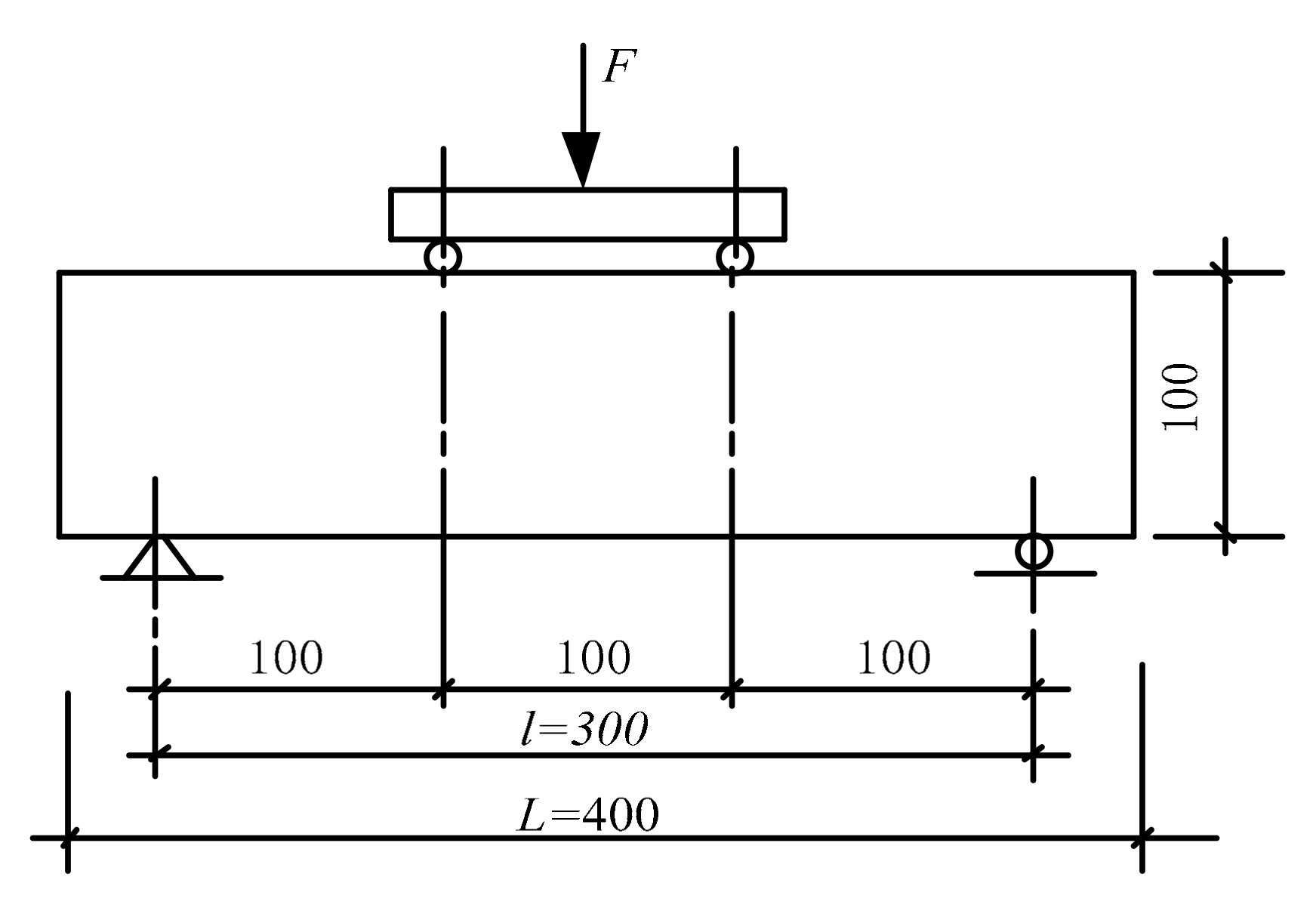
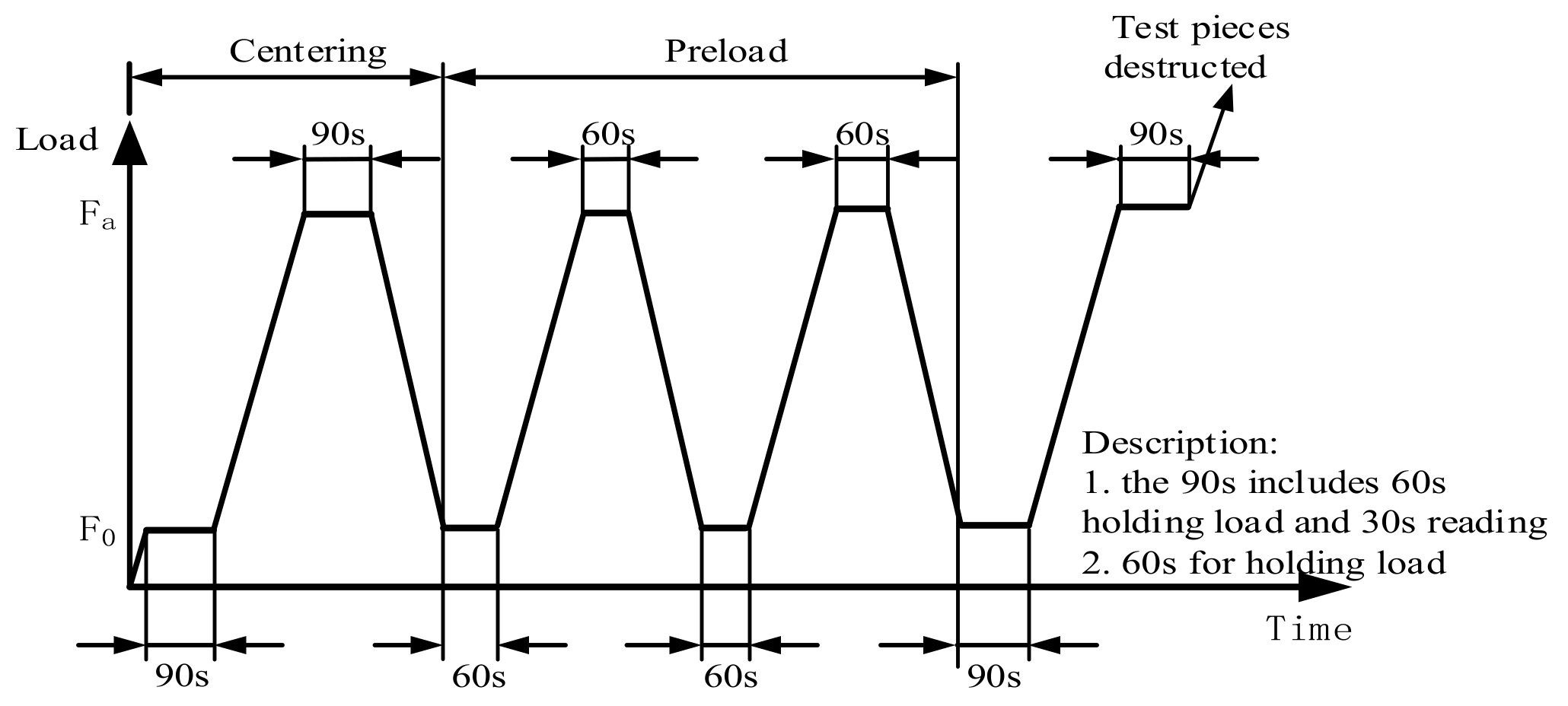
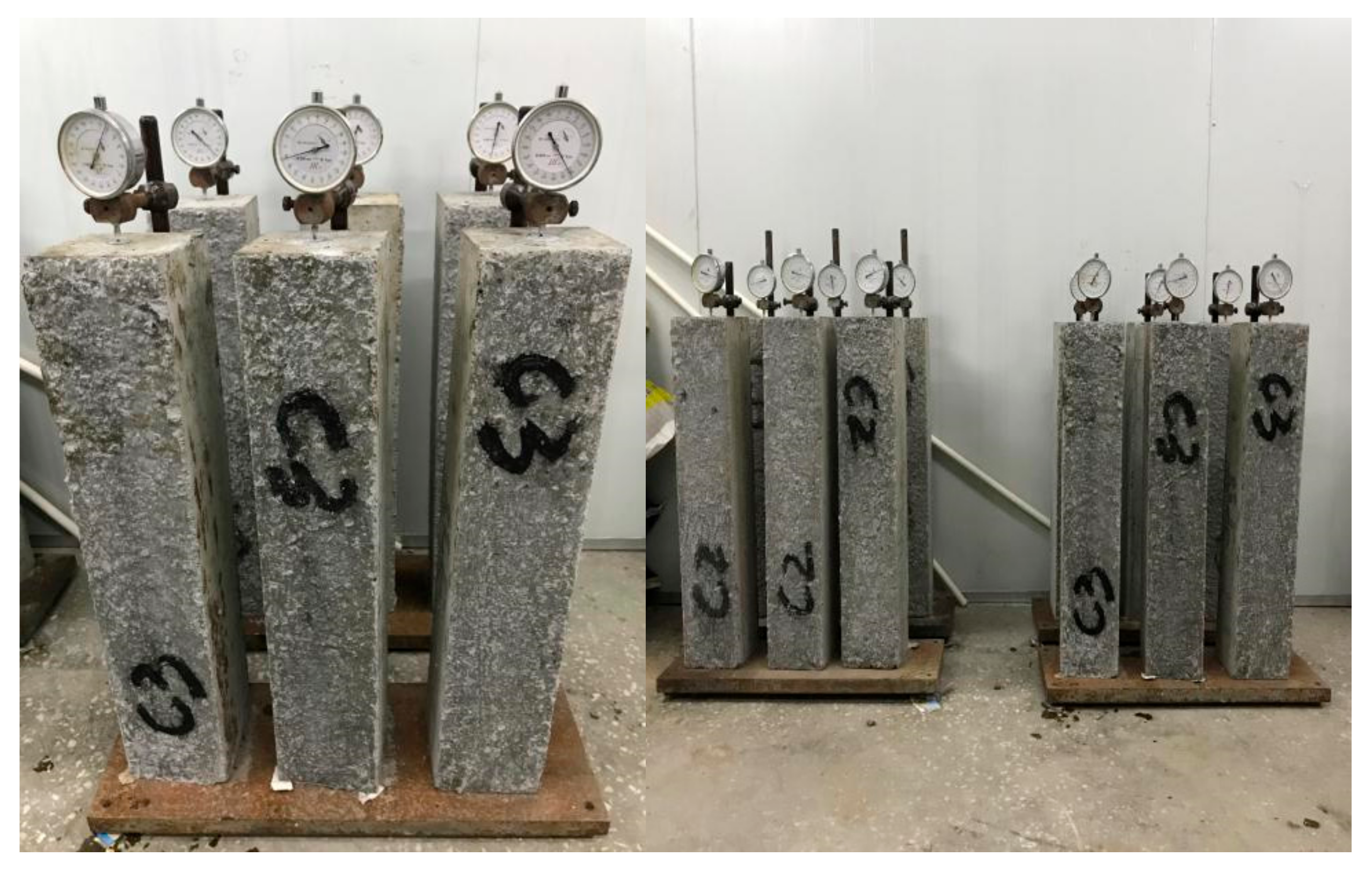

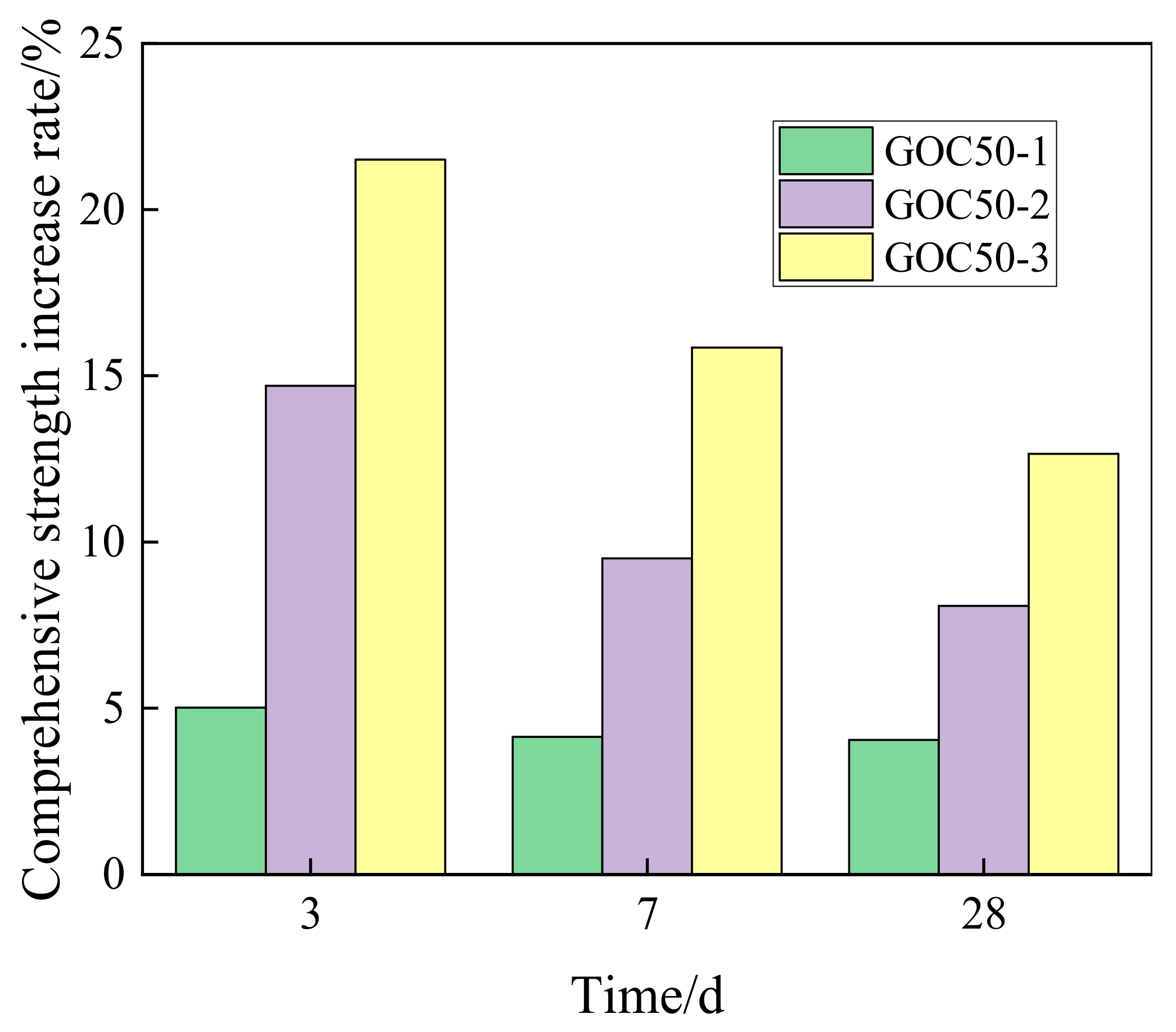


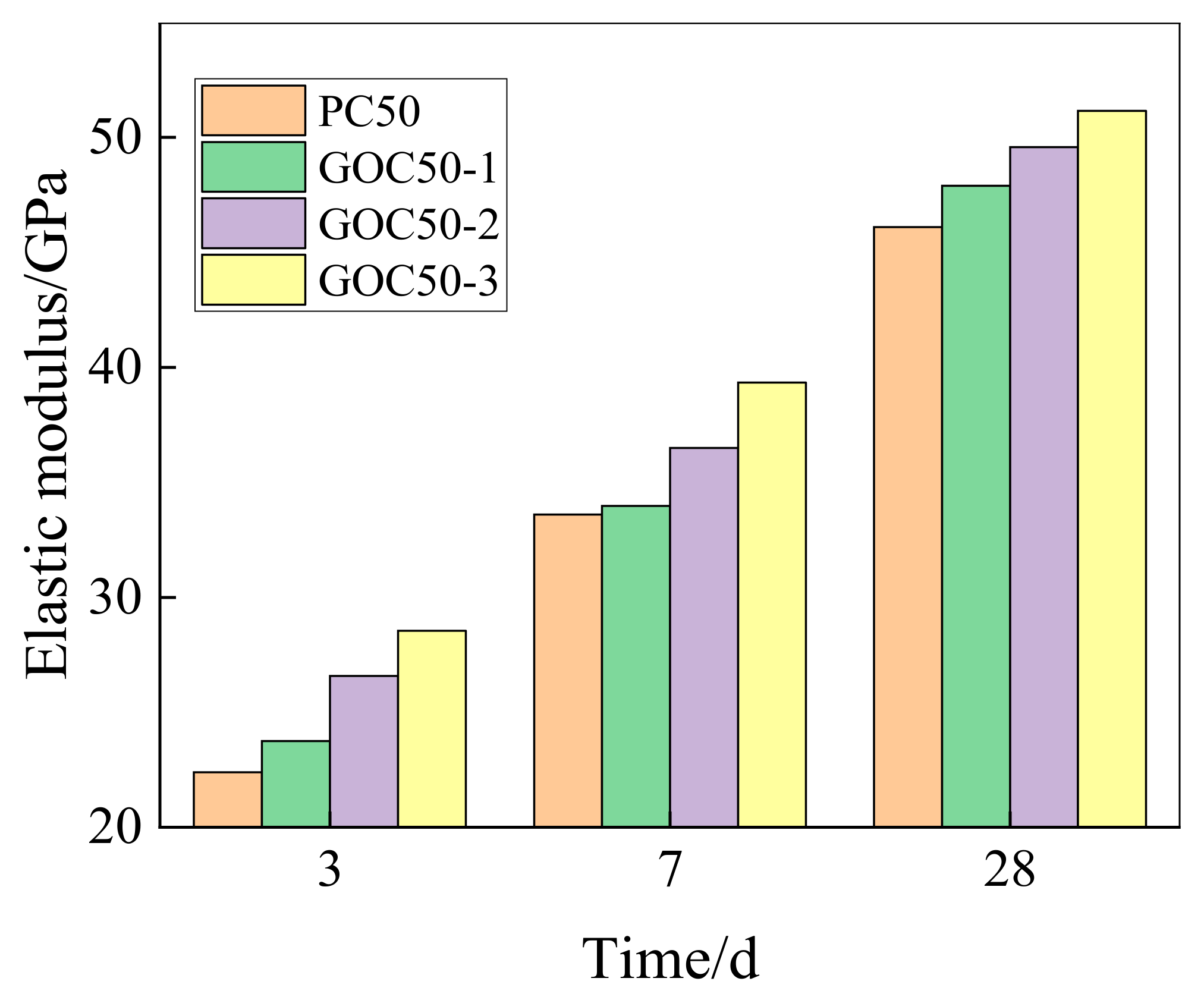
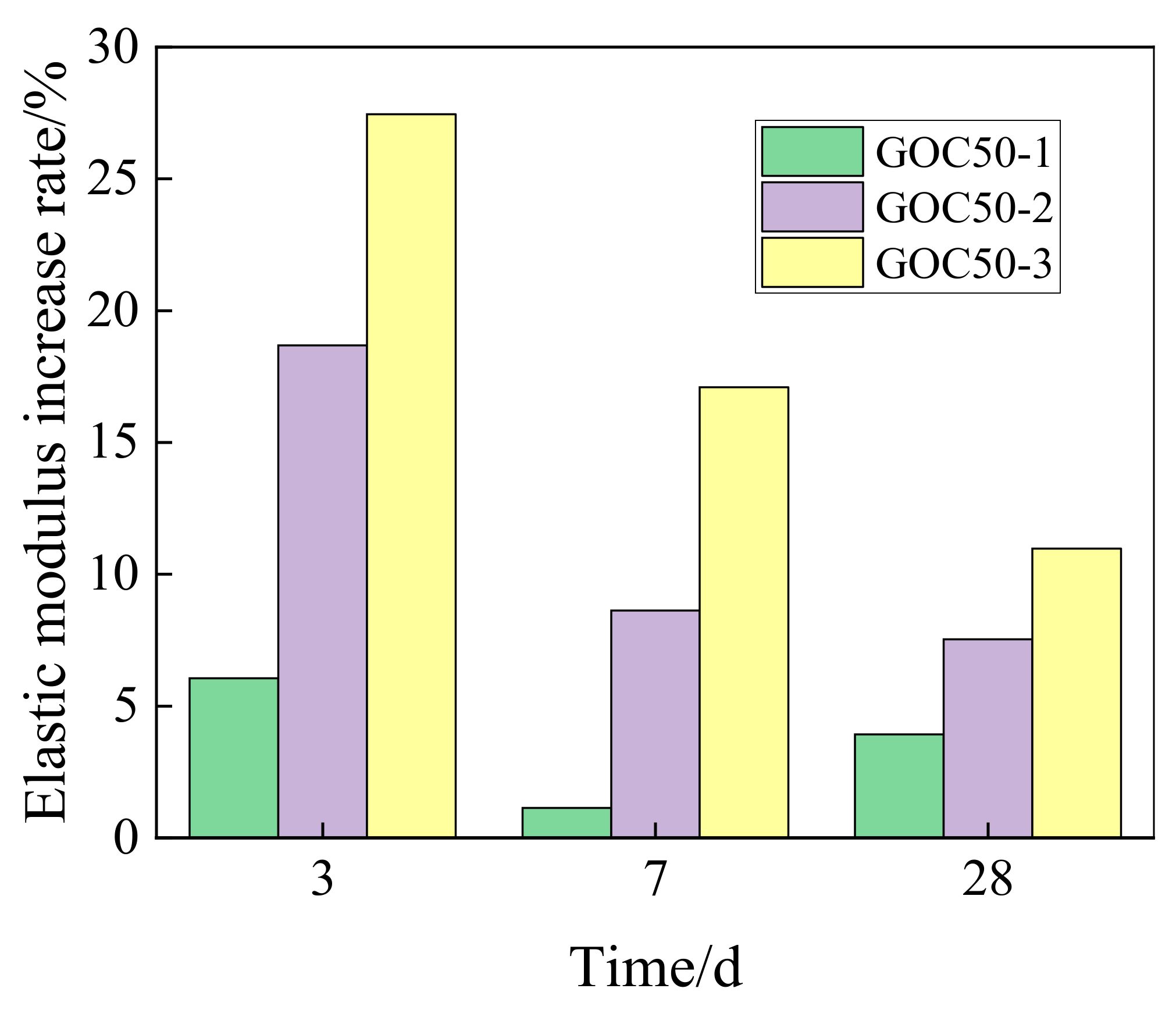


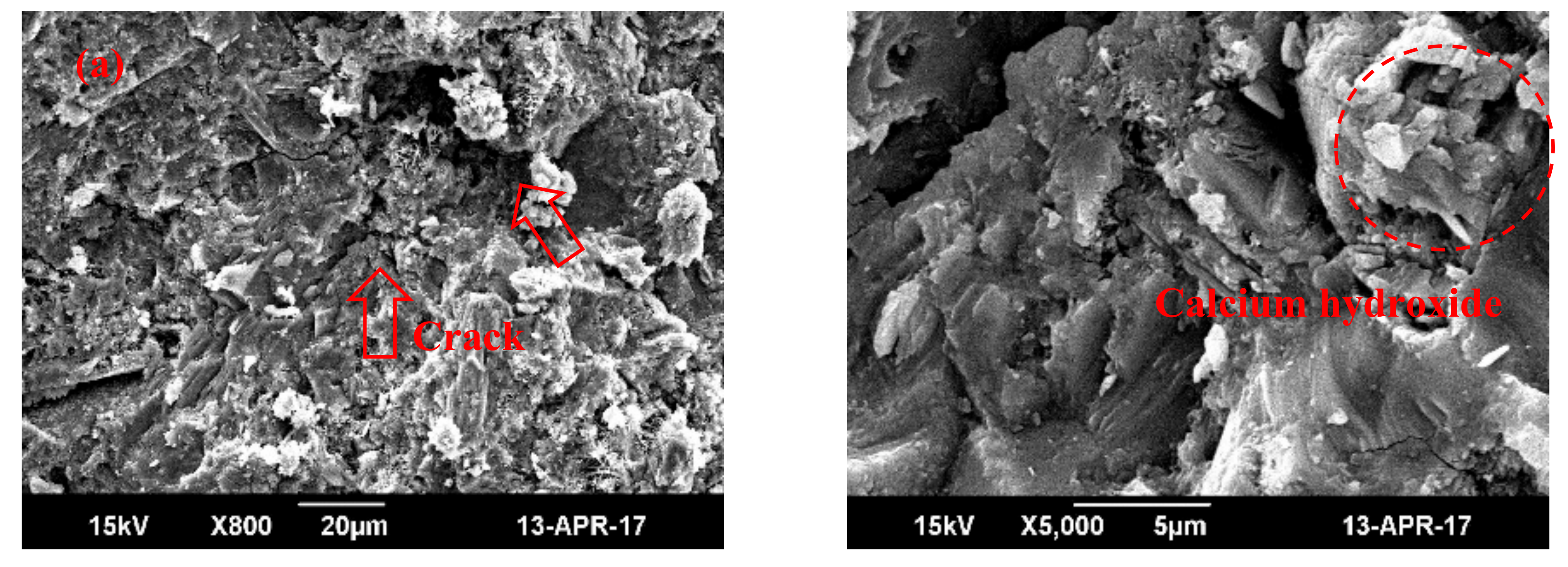
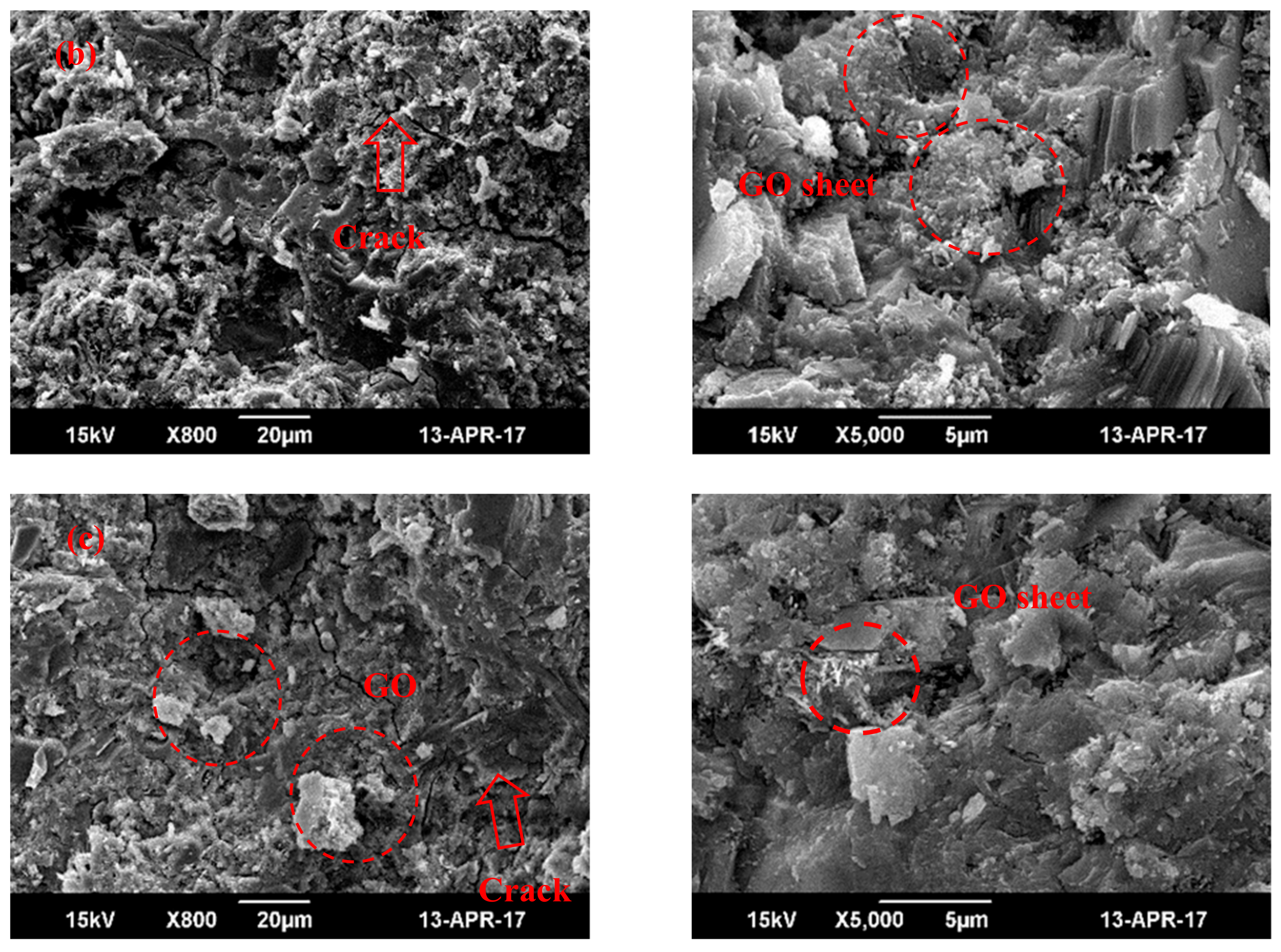
| Max Test Force (kN) | Relative Error of Test Force Value | Size of Upper and Lower Platens (mm) | Max Gap of Upper and Lower Platens (mm) | Piston Diameter (mm) | Piston Stroke (mm) | Rated Pressure of Hydraulic Pump (MPa) |
|---|---|---|---|---|---|---|
| 2000 | ≤± 1% | 3.7 × 3.7 | 320 | 250 | 50 | 40 |
| Maximum Load (kN) | Measurement Accuracy | Load Measurement Range | Deformation Measurement Range | Displacement Resolution (mm) | Constant Rate Control of Test Force | Constant Rate Control of Deformation |
|---|---|---|---|---|---|---|
| 600 | level 1 | 1–100% FS | 1–100% FS | 0.002 | (1–100%) FS/min | (1–100%) FS/min |
| Number | Cement | Fly Ash | Silica Fume | Machine-Made Sand | Coarse Aggregate | GO | Water | Polycarboxylate Superplasticizer |
|---|---|---|---|---|---|---|---|---|
| PC50 | 370 | 70 | 28 | 723 | 1085 | 0 | 164 | 6.08 |
| GOC50-1 | 370 | 70 | 28 | 723 | 1085 | 0.074 | 164 | 6.08 |
| GOC50-2 | 370 | 70 | 28 | 723 | 1085 | 0.185 | 164 | 6.08 |
| GOC50-3 | 370 | 70 | 28 | 723 | 1085 | 0.296 | 164 | 6.08 |
| Number | Cement | Machine-Made Sand | Coarse Aggregate | GO | Water |
|---|---|---|---|---|---|
| C0 | 398 | 623 | 1184 | 0 | 195 |
| C1 | 398 | 623 | 1184 | 0.080 | 195 |
| C2 | 398 | 623 | 1184 | 0.199 | 195 |
| C3 | 398 | 623 | 1184 | 0.318 | 195 |
© 2020 by the authors. Licensee MDPI, Basel, Switzerland. This article is an open access article distributed under the terms and conditions of the Creative Commons Attribution (CC BY) license (http://creativecommons.org/licenses/by/4.0/).
Share and Cite
Chen, Z.; Xu, Y.; Hua, J.; Wang, X.; Huang, L.; Zhou, X. Mechanical Properties and Shrinkage Behavior of Concrete-Containing Graphene-Oxide Nanosheets. Materials 2020, 13, 590. https://doi.org/10.3390/ma13030590
Chen Z, Xu Y, Hua J, Wang X, Huang L, Zhou X. Mechanical Properties and Shrinkage Behavior of Concrete-Containing Graphene-Oxide Nanosheets. Materials. 2020; 13(3):590. https://doi.org/10.3390/ma13030590
Chicago/Turabian StyleChen, Zengshun, Yemeng Xu, Jianmin Hua, Xu Wang, Lepeng Huang, and Xiao Zhou. 2020. "Mechanical Properties and Shrinkage Behavior of Concrete-Containing Graphene-Oxide Nanosheets" Materials 13, no. 3: 590. https://doi.org/10.3390/ma13030590
APA StyleChen, Z., Xu, Y., Hua, J., Wang, X., Huang, L., & Zhou, X. (2020). Mechanical Properties and Shrinkage Behavior of Concrete-Containing Graphene-Oxide Nanosheets. Materials, 13(3), 590. https://doi.org/10.3390/ma13030590






